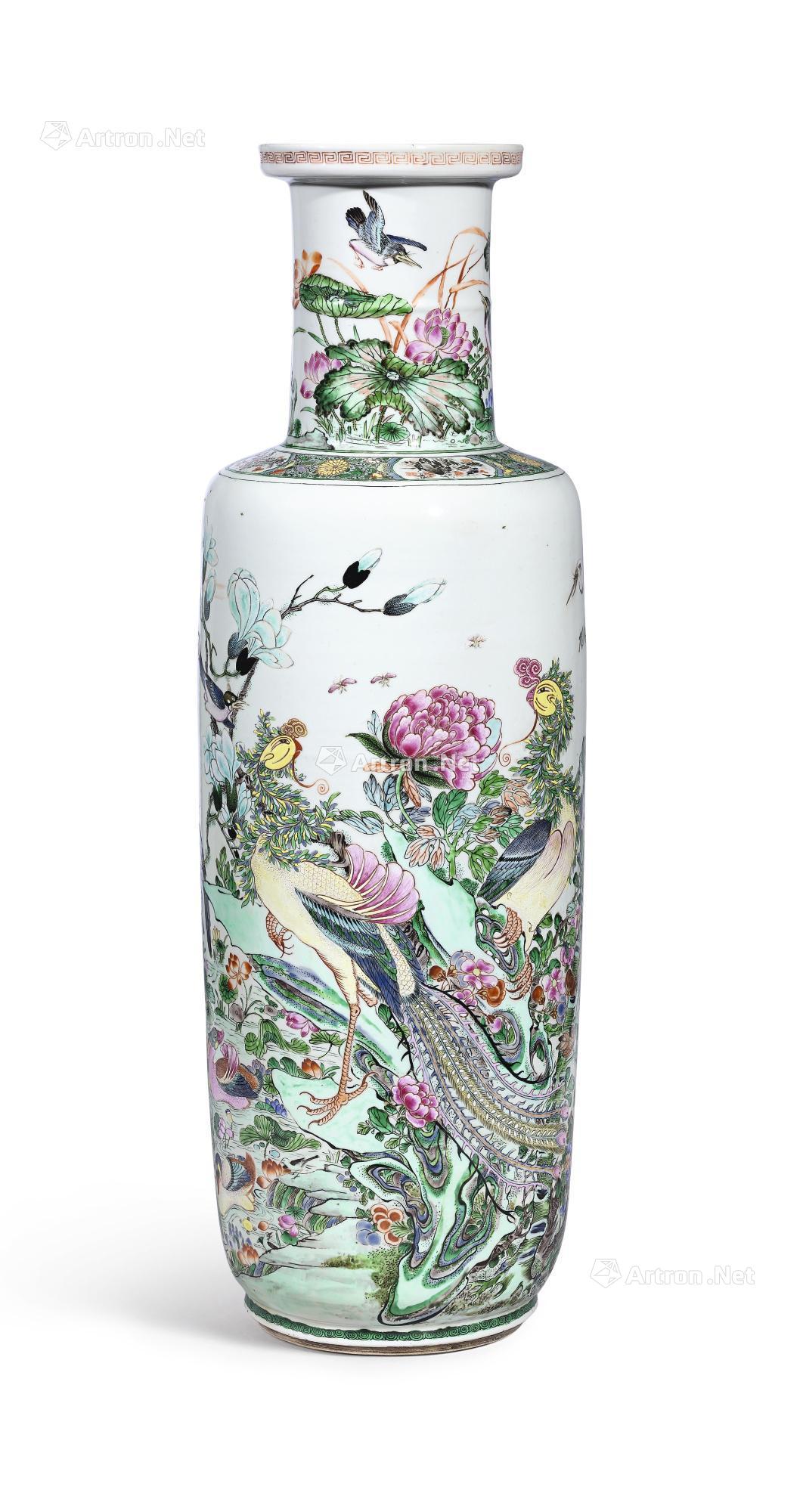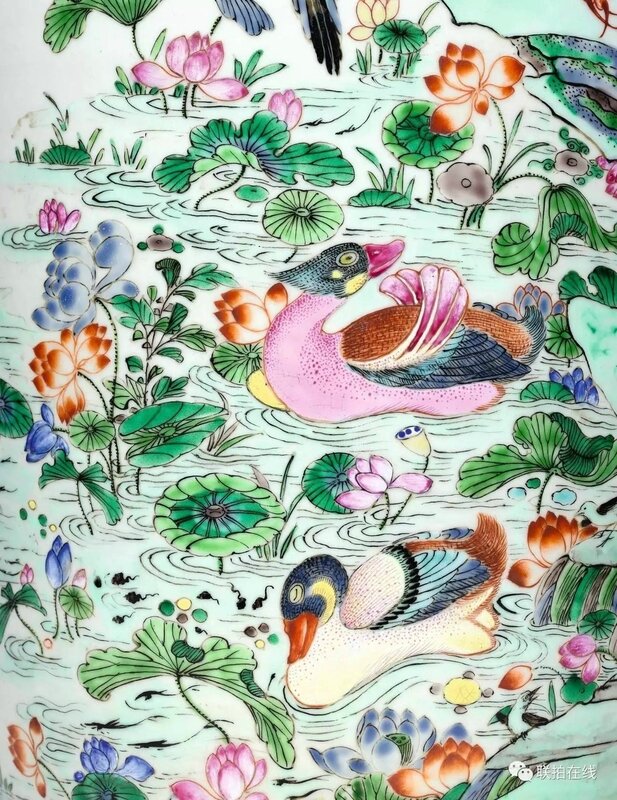萬發屯
吃喝玩樂奔諾獎
Lot 1116. A monumental and rare rose-verte 'birds' rouleau vase, Qing dynasty, Kangxi period (1662-1722), 74.7 cm, 29 3/8 in. Estimate 4,000,000 — 6,000,000 HKD. Lot sold 4,900,000 HKD. Photo: Sotheby's.
with a cylindrical body surmounted by a constricted neck and galleried rim, the body finely enamelled in the rose-verte palette with a lavish and vibrant continuous scene depicting a pair of phoenix perched on green jagged rocks, each of the mythical birds rendered with its stylised ruyi-crested head turned over its back to face the other, the verdant setting populated with several pairs of birds, including a pair of magpies in the branches of a magnolia tree, above a pair of mandarin ducks swimming in a pond accentuated with pink and blue lotus blooms and green lily pads, the reverse of the vibrant design with a pair of cranes perched on a gnarled tree trunk emerging from dense clusters of multi-coloured floral blooms picked out in yellow, pink, red and blue, including mallow, iris and large peony blooms, further decorated with a pair of sparrows portrayed in flight near a butterfly, all below a frieze encircling the neck with cartouches of crabs and shrimp, separated by yellow chrysanthemum blooms borne on stylised and floral scrolls on a stippled green ground, the cylindrical neck with a pair of kingfishers amidst bright pink lotus and large green lily leaves, all below a key-fret band encircling the rim, the base with an underglaze-blue double circle
Provenance: Santa Barbara Museum of Art, Santa Barbara, California.
Note: This magnificent rouleau vase displays the technical developments of the early Qing dynasty. Its magnificent size and striking decoration are testament to the advances in porcelain production during the early 18th century, when potters began to experiment with new enamel colours. It is one of the earliest examples of the inclusion of pink enamel amidst the famille-verte colour scheme and style.
Vases of this massive size and painted in this palette are very rare, although a closely related example from the collection of Rt. Hon. The Lord Margadale of Isley, was sold at Christie’s London, 31st May 1965, lot 67, again in these rooms, 16th May 1977, lot 216, and in our Monaco rooms, 22nd June 1987, lot 1465. Compare also a vase of similar size and shape and painted with birds and flowers, but only in the famille-verte palette, in the Metropolitan Museum of Art, New York, illustrated in Oriental Ceramics. The World’s Great Collections, vol. 11, New York, 1982, pl. 131; another sold twice at Christie’s London, 4th May 1970, lot 23, and 9th July 1985, lot 202; and a third sold in our Monaco rooms, 29th February 1992, lot 440.
The use of pink enamel with overglaze blue and broad washes of green enamel indicates that this piece was made in the late Kangxi period, when the wucai colour scheme was gradually replaced by famille-rose enamels, hence the name of this palette, rose-verte. Numerous scholars have discussed the origins and far reaching consequences of the introduction of pink enamel in the Qing dynasty, which together with the development of opaque white and opaque yellow changed dramatically the outlook of porcelain produced at Jingdezhen. Nigel Wood, who examined in depth the chemical composition of these porcelain colours, suggests that while the white and yellow enamels probably derived from enamels used on cloisonné ware, pink enamel was probably introduced in China from Europe through Jesuit missionaries. A gold-pink enamel was in use at the Meissen factory in Saxony in about 1718, and the pink enamel of Jingdezhen similarly appears to contain minute traces of colloidal gold (see Nigel Wood, Chinese Glazes, Hong Kong, 1999, pp. 241-243).
The appearance of overglaze blue enamel, which slightly predated that of pink in the 1720s, similarly had an important impact on porcelain decoration. Appearing first during the reign of the Kangxi Emperor, overglaze blue simplified the making of famille-verte wares, enabling porcelain painters to create highly sophisticated motifs. In the Ming dynasty underglaze cobalt blue had to be applied before firing to those areas where it would later be needed, while the other colours were added after the firing to make up the complete polychrome design; in the Qing, underglaze blue was omitted or exchanged for overglaze blue, which was applied together with the other colours, thus allowing much more complex and detailed designs. Overglaze blue enamel is mentioned in a letter by the Jesuit missionary Père François d’Entrecolles (1664-1741), who noted that this glaze was made from a powdered blue glass, which would be mixed with gum and fish-glue. The advantages of using overglaze blue are evident in the attractive rendering of the flowers and where it has been employed to enhance the naturalism of the birds’ feathers.
The subject on this piece is notable for its auspicious meaning. As the phoenix is the king of birds, the subject of phoenix surrounded by many birds is known as ‘hundred birds courting the phoenix’ (bainiaochaohuang or bainiaochaofeng). Since the phoenix only appears during peaceful reigns, it is closely connected with the ruler, and this motif stands for the relationship between a ruler and his officials. The birds depicted in such scenes carry symbolic meaning and represent the ‘Picture of the Five Relationships’ (luxutu, wuluntu); the cranes represent the relationship between father and son; mandarin ducks the relationship between husband and wife; wagtails the relationship between brothers; and the relationship between friends is represented by the orioles.
Sotheby's. Chinese Art from Two American Private Collections, Hong Kong, 05 Apr 2017
來源:聖塔巴巴拉藝術博物館,加州聖塔巴巴拉
本品工藝始於清初,尺寸碩大,紋飾富麗,彰顯十八世紀早期製瓷工藝之卓絕,對新進釉色之探索推陳出新,在五彩基礎上添飾粉紅,屬當時創燒雛例。
相類大尺寸且紋飾相近瓶例不為多見,但可比較一例,屬艾雷島 Margadale 勳爵舊藏,售於倫敦佳士得1965年5月31日,編號67,後售於香港蘇富比1977年5月16日,編號216,後又於摩納哥蘇富比1987年6月22日,編號1465。另可參考一尺寸器形相近之例,繪五彩花鳥紋,藏紐約大都會藝術博物館,載於《東洋陶磁大觀》,卷11,紐約,1982年,圖版131。另有一例兩度售於倫敦佳士得,分別於1970年5月4日,編號23,及1985年7月9日,編號202。第三例則售於摩納哥蘇富比1992年2月29日,編號440。
此瓶見粉紅彩、釉上藍彩及綠彩暈染,乃屬康熙晚期製作,時五彩漸為粉彩所替,其遂得名五彩加粉彩。關於清代引入粉紅彩之來源及深遠影響,以及不透明白、黃色彩之發展,曆來學者討論頗多。諸上種種,使得景德鎮所製瓷器麵貌發生顯著改變。學者 Nigel Wood 對此類彩化學成分進行研究,認為此類不透明白、黃彩或源於琺琅器,而粉紅彩則可能從歐洲經天主教傳教士進入中國。德國薩克森之麥森瓷廠約於1718年已有采用以金發色之粉紅彩,彩料成份與景德鎮粉紅彩同樣含有微量熔金(參見Nigel Wood,《Chinese Glazes》,香港,1999年,頁341-343)。
釉上藍彩則首現於1720年代,較粉紅彩略早,深刻影響後期同類器物燒造。首例創於康熙年間,此藍彩之發明,簡化五彩瓷窯燒工藝,器身可飾以繁複紋飾。明代五彩須先於成形素胎施青花鈷藍料勾繪圖案輪廓,經高溫燒製成釉下青花,後填釉上彩繪紋飾細節,經二次低溫燒製,最終成型。清代釉上藍取代釉下鈷藍,與其他彩料繪於白胎之上,因而可繪細節入微。天主教傳教士殷弘緒書信中曾有提及,釉上藍彩,采藍色玻璃磨粉,混以樹膠及魚膠而成,以釉上藍繪製尤顯花卉層次,遂特別用於繪製翎羽,以使其更顯惟妙惟肖。
此瓶題材寓意深長,鳳凰尊百鳥之王,百鳥環繞,取其「百鳥朝凰、百鳥朝鳳」之美意。鳳凰僅見於太平盛世,鳥中之長,意指君王,臨天下,尊攝百官,寓君臣之義。圖中鳥雀各類,代表「五倫」之道,鳳示君臣,鶴示父子,鴛鴦示夫妻,鶺鴒示兄弟,黃鶯示朋友。








有時間我也看看
前兩天看BBC鑒寶節目,有個人花十個英鎊,買下底部還是裂口的一個粉彩花瓶,日本的,專家說價值在7000到8000 英鎊之間。